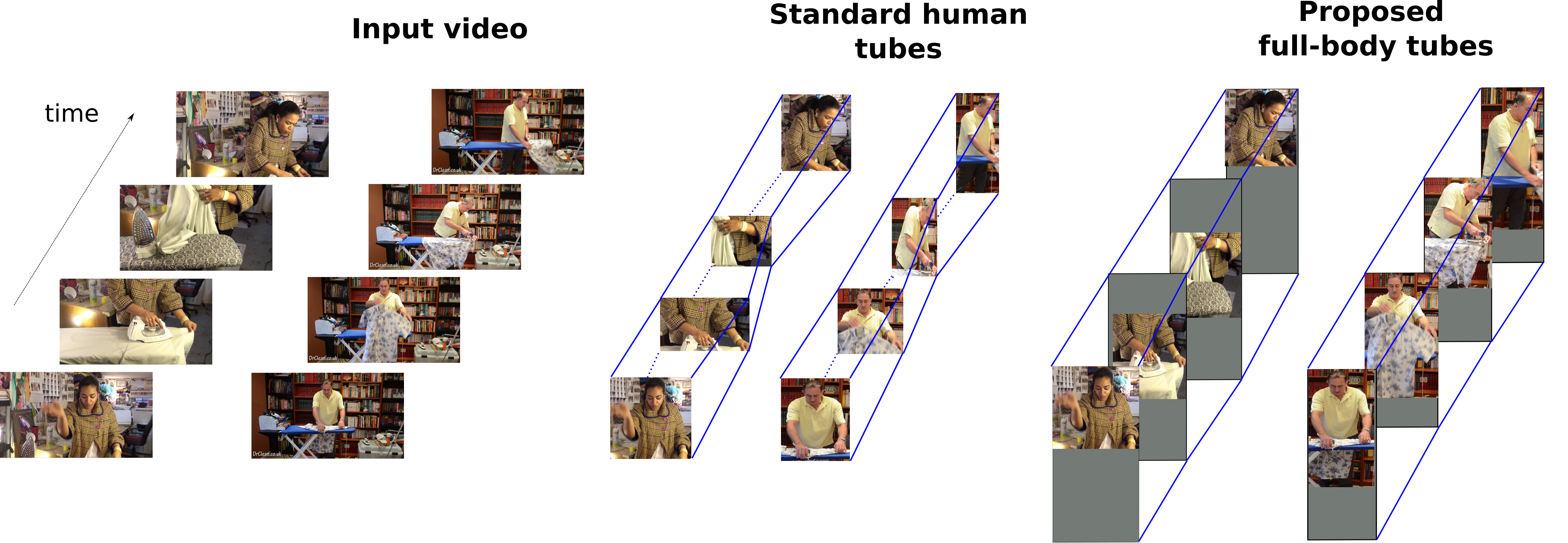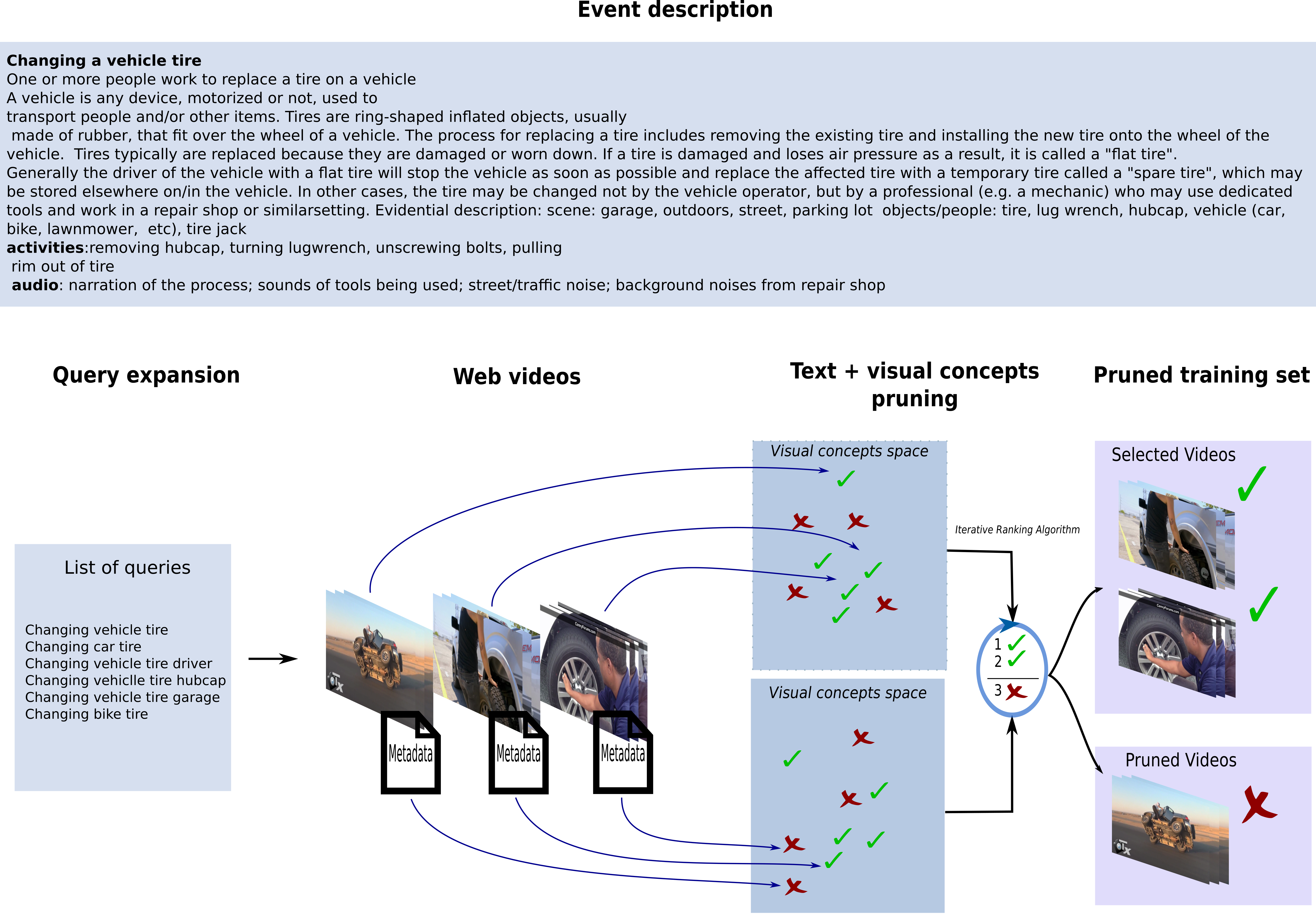Section: New Results
Visual recognition in videos
Detecting Parts for Action Localization
Participants : Nicolas Chesneau, Grégory Rogez, Karteek Alahari, Cordelia Schmid.
we propose a new framework for action localization that tracks people in videos and extracts full-body human tubes, i.e., spatio-temporal regions localizing actions, even in the case of occlusions or truncations. This is achieved by training a novel human part detector that scores visible parts while regressing full-body bounding boxes. The core of our method is a convolutional neural network which learns part proposals specific to certain body parts. These are then combined to detect people robustly in each frame. Our tracking algorithm connects the image detections temporally to extract full-body human tubes. We apply our new tube extraction method on the problem of human action localization, on the popular JHMDB dataset, and a very recent challenging dataset DALY (Daily Action Localization in YouTube), showing state-of-the-art results. An overview of the method is show in Figure 12. More details are provided in [15].
|
Learning from Web Videos for Event Classification
Participants : Nicolas Chesneau, Karteek Alahari, Cordelia Schmid.
Traditional approaches for classifying event videos rely on a manually curated training dataset. While this paradigm has achieved excellent results on benchmarks such as TrecVid multimedia event detection (MED) challenge datasets, it is restricted by the effort involved in careful annotation. Recent approaches have attempted to address the need for annotation by automatically extracting images from the web, or generating queries to retrieve videos. In the former case, they fail to exploit additional cues provided by video data, while in the latter, they still require some manual annotation to generate relevant queries. We take an alternate approach in this paper, leveraging the synergy between visual video data and the associated textual metadata, to learn event classifiers without manually annotating any videos. Specifically, we first collect a video dataset with queries constructed automatically from textual description of events, prune irrelevant videos with text and video data, and then learn the corresponding event classifiers. We evaluate this approach in the challenging setting where no manually annotated training set is available, i.e., EK0 in the TrecVid challenge, and show state-of-the-art results on MED 2011 and 2013 datasets. An overview of the method is show in Figure 13. More details are provided in [4].
|
Learning Motion Patterns in Videos
Participants : Pavel Tokmakov, Karteek Alahari, Cordelia Schmid.
The problem of determining whether an object is in motion, irrespective of the camera motion, is far from being solved. We address this challenging task by learning motion patterns in videos [26]. The core of our approach is a fully convolutional network (see Figure 14), which is learnt entirely from synthetic video sequences, and their ground-truth optical flow and motion segmentation. This encoder-decoder style architecture first learns a coarse representation of the optical flow field features, and then refines it iteratively to produce motion labels at the original high-resolution. The output label of each pixel denotes whether it has undergone independent motion, i.e., irrespective of the camera motion. We demonstrate the benefits of this learning framework on the moving object segmentation task, where the goal is to segment all the objects in motion. To this end we integrate an objectness measure into the framework. Our approach outperforms the top method on the recently released DAVIS benchmark dataset, comprising real-world sequences, by 5.6%. We also evaluate on the Berkeley motion segmentation database, achieving state-of-the-art results.
|
Learning Video Object Segmentation with Visual Memory
Participants : Pavel Tokmakov, Karteek Alahari, Cordelia Schmid.
This paper [27] addresses the task of segmenting moving objects in unconstrained videos. We introduce a novel two-stream neural network with an explicit memory module shown in Figure 15 to achieve this. The two streams of the network encode spatial and temporal features in a video sequence respectively, while the memory module captures the evolution of objects over time. The module to build a "visual memory" in video, i.e., a joint representation of all the video frames, is realized with a convolutional recurrent unit learned from a small number of training video sequences. Given a video frame as input, our approach assigns each pixel an object or background label based on the learned spatio-temporal features as well as the "visual memory" specific to the video, acquired automatically without any manually-annotated frames. The visual memory is implemented with convolutional gated recurrent units, which allows to propagate spatial information over time. We evaluate our method extensively on two benchmarks, DAVIS and Freiburg-Berkeley motion segmentation datasets, and show state-of-the-art results. For example, our approach outperforms the top method on the DAVIS dataset by nearly 6%. We also provide an extensive ablative analysis to investigate the influence of each component in the proposed framework.
|
Learning to Segment Moving Objects
Participants : Pavel Tokmakov, Cordelia Schmid, Karteek Alahari.
We study the problem of segmenting moving objects in unconstrained videos [37]. Given a video, the task is to segment all the objects that exhibit independent motion in at least one frame. We formulate this as a learning problem and design our framework with three cues: (i) independent object motion between a pair of frames, which complements object recognition, (ii) object appearance, which helps to correct errors in motion estimation, and (iii) temporal consistency, which imposes additional constraints on the segmentation. The framework is a two-stream neural network with an explicit memory module, shown in Figure 15. The two streams encode appearance and motion cues in a video sequence respectively, while the memory module captures the evolution of objects over time, exploiting the temporal consistency. The motion stream is a convolutional neural network trained on synthetic videos to segment independently moving objects in the optical flow field. The module to build a “visual memory” in video, i.e., a joint representation of all the video frames, is realized with a convolutional recurrent unit learned from a small number of training video sequences. For every pixel in a frame of a test video, our approach assigns an object or background label based on the learned spatio-temporal features as well as the “visual memory” specific to the video. We evaluate our method extensively on three benchmarks, DAVIS, Freiburg-Berkeley motion segmentation dataset and SegTrack. In addition, we provide an extensive ablation study to investigate both the choice of the training data and the influence of each component in the proposed framework.
Joint learning of object and action detectors
Participants : Vasiliki Kalogeiton, Philippe Weinzaepfel, Vittorio Ferrari, Cordelia Schmid.
While most existing approaches for detection in videos focus on objects or human actions separately, we aim at jointly detecting objects performing actions, such as cat eating or dog jumping [19]. We introduce an end-to-end multitask objective that jointly learns object-action relationships, see Figure 16. We compare it with different training objectives, validate its effectiveness for detecting objects-actions in videos, and show that both tasks of object and action detection benefit from this joint learning. Moreover, the proposed architecture can be used for zero-shot learning of actions: our multitask objective leverages the commonalities of an action performed by different objects, e.g. dog and cat jumping , enabling to detect actions of an object without training with these object-actions pairs. In experiments on the A2D dataset, we obtain state-of-the-art results on segmentation of object-action pairs. We finally apply our multitask architecture to detect visual relationships between objects in images of the VRD dataset.
|
Action Tubelet Detector for Spatio-Temporal Action Localization
Participants : Vasiliki Kalogeiton, Philippe Weinzaepfel, Vittorio Ferrari, Cordelia Schmid.
Current state-of-the-art approaches for spatio-temporal action detection rely on detections at the frame level that are then linked or tracked across time. In this paper [18], we leverage the temporal continuity of videos instead of operating at the frame level. We propose the ACtion Tubelet detector (ACT-detector) that takes as input a sequence of frames and outputs tubelets, ie., sequences of bounding boxes with associated scores, see Figure 17. The same way state-of-the-art object detectors rely on anchor boxes, our ACT-detector is based on anchor cuboids. We build upon the state-of-the-art SSD framework. Convolutional features are extracted for each frame, while scores and regressions are based on the temporal stacking of these features, thus exploiting information from a sequence. Our experimental results show that leveraging sequences of frames significantly improves detection performance over using individual frames. The gain of our tubelet detector can be explained by both more relevant scores and more precise localization. Our ACT-detector outperforms the state of the art methods for frame-mAP and video-mAP on the J-HMDB and UCF-101 datasets, in particular at high overlap thresholds.
|








